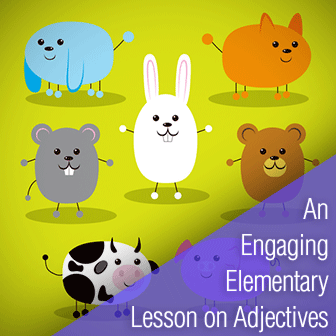Amazing Animals: A Super-Engaging Elementary Lesson on Adjectives


Picture books can be a great help in reading and writing lessons and can even be the basis of a conversation class. For vocabulary lessons, simple books with repeating phrases are particularly useful. One such book is Bill Martin’s Brown Bear, Brown Bear, What do You See? which teaches basic colors and animal vocabulary. If you have beginning students who need a lesson or a review on colors and animals, here are some activities you can try. Your kids will have fun, and they will learn as they play with Martin’s prose.

Start by reading the book to your class. It is best if you can introduce the book before you plan to do the rest of the activities so your students have some familiarity with it.
On the day you plan to start the activities, read the book to your class again. After you read, give each student a picture of one of the animals in the book, and ask them to color the animal like the one in the book. (Busy Teacher has hundreds of free coloring pages you can use in class, including some for animals!) Make sure you have at least one of each animal represented in your class, and having multiples of the animals is okay, too. Have each student cut out his or her picture and glue it to a paper plate. Then, have them glue or tape a tongue depressor to the plate. Each person now has a mask which shows one of the animals in the book.
With your students holding their masks, read the book again and have each person stand when his animal is speaking. Have your students sit down again when the next animal speaks. After you read the entire book, say each animal again and have your students stand for their animal.
On the following day, repeat the activity. Then have student exchange masks and read the story again. They should stand when the animal on their mask is speaking. If any of your students have learned the chant, encourage them to say it along with you.
Then rearrange your students so they are sitting in the same order as the animals in the book. Starting at the beginning of the line, ask each student what he sees. “Sam, what do you see?” for example. The student should answer with the name of the animal next to him. He can say either the animal’s name (e.g. red bird) or the entire phrase (I see a red bird looking at me).To make sure everyone has practice with more than one animal, have your students exchange masks and repeat the activity. Continue until every student has had the opportunity to be each of the animals in the book.
On the third day, prepare for your color and animal lesson by hanging poster paper in the front of your room, one page for each of the animals, and glue a picture of each animal to a poster. Distribute the masks again before reading the book one more time, and encourage your class to chant along with you. Many of them will be good at it by now. Like the previous two days, have each person stand when his animal is speaking.
Tell your students that now you are going to play a game. You will say their name and ask them what they see. They should respond by naming an object in the room as well as its color. For example:
Give each of your students at least one turn.
Then, make available to your students some old magazines. Tell each person that she should find one picture among the magazines for each of the animals, and the color of the object should match the color of the animal. When a student finds an appropriate picture, have her come to the front of the room and point out the poster where her picture belongs. She should also tell you the color of her object. Then have her glue her picture to the correct poster. Give your class enough time so everyone can find one picture for each of the animals. When you finish, you should have a collage of magazine pictures for each color in the book. You should also have a good read on how well your students have learned their colors.
Once your students know their colors and animals, there are many follow up activities you can do to reinforce their new vocabulary. Check out Busy Teacher for some creative ideas.
What picture books have you used most often in your ESL classroom?